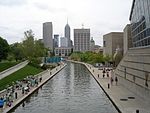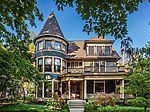Damien Center
Buildings and structures in IndianapolisHIV/AIDS organizations in the United StatesHealthcare in IndianapolisNon-profit organizations based in IndianapolisOrganizations established in 1987
The Damien Center is the largest care center (providing both health and counseling services) for people with HIV/AIDS in Indianapolis, Indiana. It has been open since 1987 and is the longest-sustained project of the Indy Bag Ladies.
Excerpt from the Wikipedia article Damien Center (License: CC BY-SA 3.0, Authors).Damien Center
North Arsenal Avenue, Indianapolis Arsenal Heights (Near Eastside)
Geographical coordinates (GPS) Address Nearby Places Show on map
Geographical coordinates (GPS)
| Latitude | Longitude |
|---|---|
| N 39.7679 ° | E -86.1337 ° |
Address
Damien Center
North Arsenal Avenue 26
46201 Indianapolis, Arsenal Heights (Near Eastside)
Indiana, United States
Open on Google Maps









